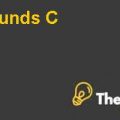Question 1
The airlines margin since the deregulation in 1978, were below the average margin for the US industries due to which each of the five largest carriers have earned returns on investment below their cost of capital. The airline companies in the industry had operated for 40 years under the regulation of the Civil Aeronautics Board (CAB) prior to 1978. The Civil Aeronautics Board (CAB) was responsible for managing the routes of each carrier, and it protected the revenues and profitability of the companies.
However, being protected by the –cost plus pricing, airlines companies commonly agreed to the demands of the labor union. Due to the industry’s environment during the regulation, the airline companies used to charge higher prices for the tickets that was double than what they used to charge in the deregulated environment in order to compensate the costs.
Moreover, the airline companies found themselves with expensive labor and high fixed cost after the deregulation of the industry. Due to this reason, the airline companies started to find out ways to gain productivity and customer loyalty as well as exposing other routes and decreasing the cost. In addition to this, after the deregulation airline companies also focused on developing the system that would help them in getting high load factors and thus, the airline companies started to pursue higher returns.
Along with all these problems associated with the cost, the large carriers had to fight with the Low Cost Carriers that entered the airline industry after the deregulation and were achieving the market share rapidly. Therefore, the condition of the airline industry during the regulations and its effects after the deregulation along with increasing competition from the Low Cost Carriers are the factors due to which none of the five largest carriers in the airline industry earned its cost of capital.
Question 2
The Southwest Airlines and JetBlue have differentiated themselves from the other airlines in the industry by offering low cost services to the customers that allow them to earn desirable returns even when the industry environment changes. These both carriers have focused on providing the low-fare and point-to-point carrier with the highest frequency to the customers in order to maintain their growth in the industry. The factor that plays an important part in the success of these two low-cost carriers is the direct competition with the other means of traveling. This helps the Southwest Airlines and JetBlue to gain the profitability during the time period when the condition of the industry is worst.
The Southwest Airlines compete for their customers by providing cars, buses and coaches while on the other hand, Jet Blue offers low fares that are attractive to the bankers, fashion models, finance officers as well as brokers.
However, Southwest Airlines and JetBlue did not compete directly with the larger airlines and focused on the airports that are not served by larger airlines. These factors have played significant role in the success of the Southwest Airlines and JetBlue. In addition to this, Southwest Airlines have set the prices of its service offerings very low in order to compete with the cost of the traveler of auto that result in high load factors instead of competing with other airlines.
Furthermore, the strategy of Southwest Airlines and JetBlue is to compete with other means of traveling and other large airlines which gives them an advantage over other larger airlines. Also, it helps them to survive and achieve profit when the other airlines are incurring significant losses in the industry. They provide point to point services to the customers between the secondary airports that lead them to compete with other traveling alternatives.
As they offer their services at compatible prices that allow them to compete with other means of traveling such as travelling by road. The demand of customers for these low cost carriers is high instead of traveling by road. However, due to these reasons declining conditions of the airline industry and the terrorist attack of 11 September, 2001 did not impact the growth and profitability of Southwest Airlines and JetBlue.
Question 3
There are several big legacy carriers that attempt to launch low-cost subsidiaries, but no airline company obtained the success in their effort. However, there are various factors that contributed to the failure of low-cost subsidiaries of legacy airlines including Delta Express. They are the high cost big legacy carriers that started selling cheap seats which is another reason behind their failure..............................
This is just a sample partial case solution. Please place the order on the website to order your own originally done case solution.
Top management of Delta Air Lines has to decide how to respond to the threat posed by low-cost carriers such as Southwest and JetBlue. Among the options under consideration is to launch low-cost subsidiary of Delta itself. Before the efforts to launch low-cost subsidiary, on Delta and other full-service airlines, were not successful. Delta can develop the best answer? "Hide
by Jan W. Rivkin, Laurent Therivel Source: HBS Premier Case Collection 15 pages. Publication Date: 20 January 2004. Prod. #: 704403-PDF-ENG














